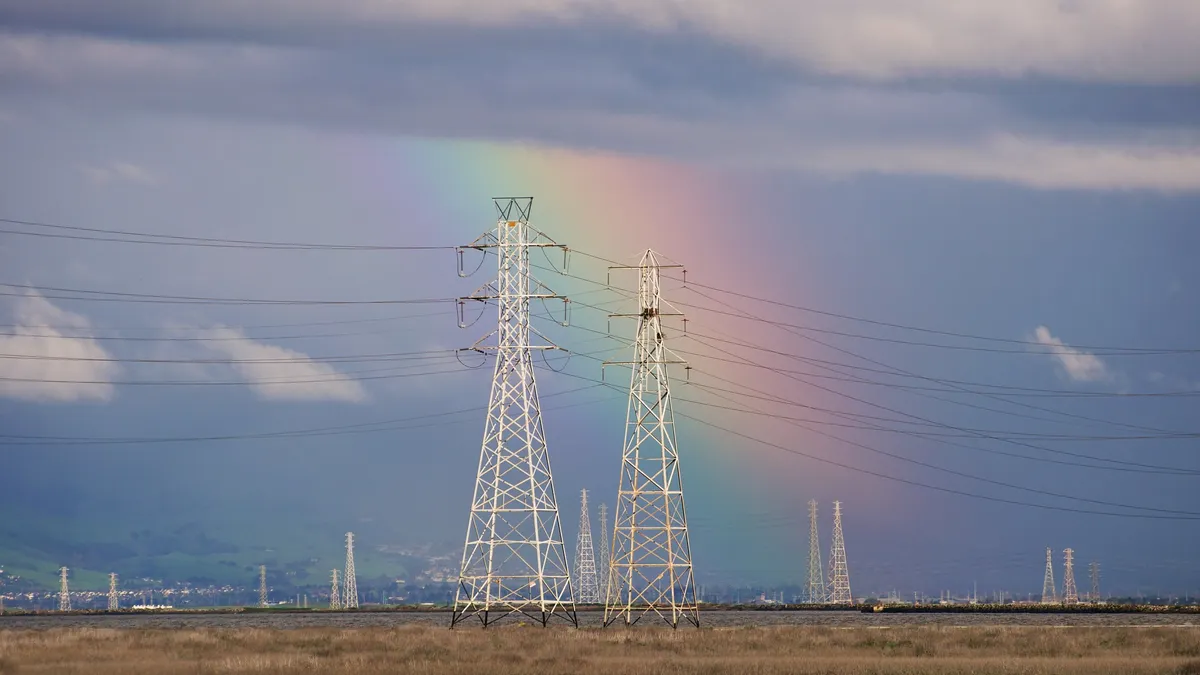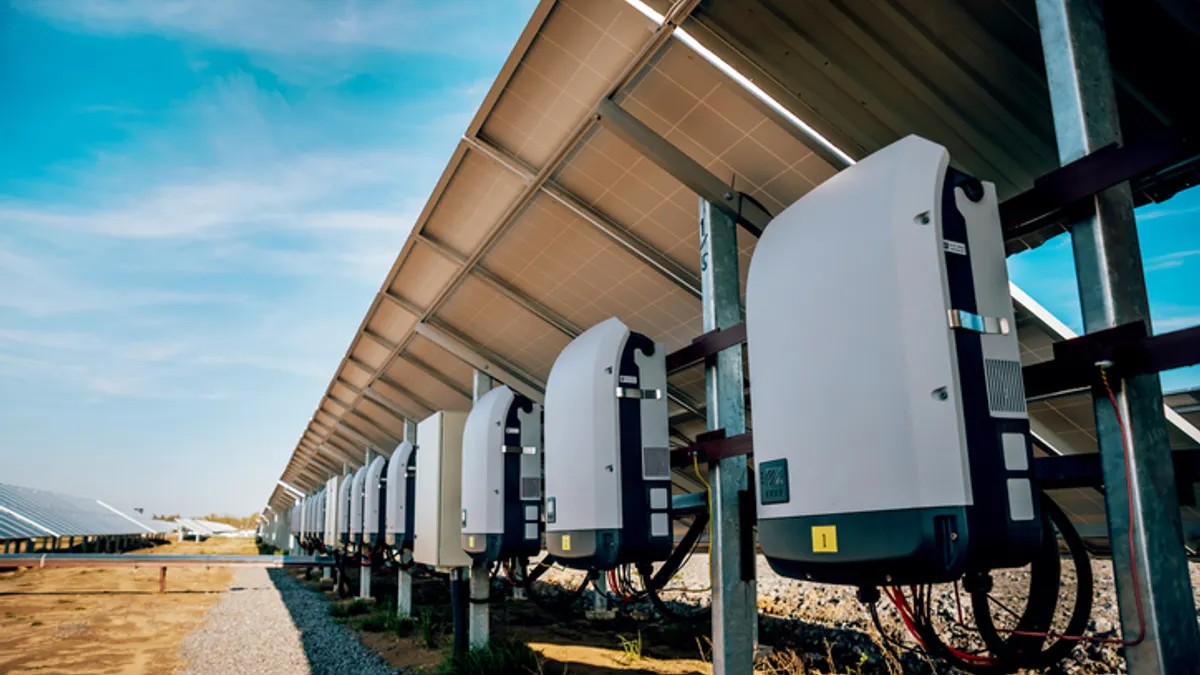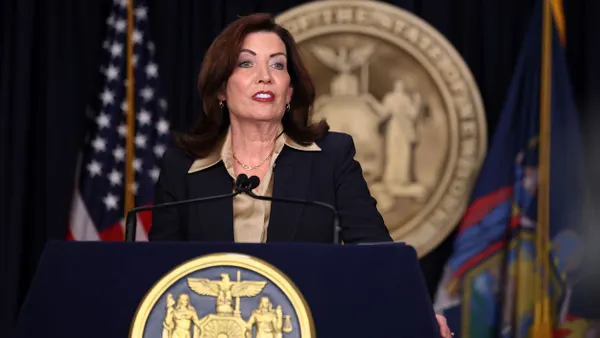After years of studies showing a national transmission system is the most cost-effective way to meet growing clean energy and carbon reduction mandates, there is still no nation-spanning solution.
New initiatives at the Department of Energy and the Federal Energy Regulatory Commission are refocusing on that goal. A modern “macrogrid” could access the nation’s diverse clean energy from coast to coast to affordably protect against extreme weather, cyber, and demand spike reliability threats, power system analysts told a March 15 Department of Energy (DOE) webinar.
“A national macrogrid system is an important concept and FERC’s outreach to state and regional stakeholders and DOE’s ongoing study can resolve a lot of the doubts about it,” former Federal Energy Regulatory Commission (FERC) Chair said James Hoecker, now Husch Blackwell senior counsel and energy strategist and Hoecker Energy Law and Policy principal told Utility Dive.
The longstanding hesitation on building a nationally interconnected system “shows the lack of political courage to deal with tough issues, and recent power outages in California and Texas show the consequences,” added former FERC Commissioner Nora Mead Brownell, now a venture partner with Clean Energy Ventures. “An independent DOE review can show the economic, social, and environmental benefits are far greater than the costs of inaction.”
The proposed 2023 Biden budget’s over $3 billion for new transmission adds momentum to a DOE National Transmission Planning Study and FERC efforts to answer key questions like who will pay and where to build, transmission analysts said. Joint federal, regional, and local advocacy could be the way to resolve objections to connecting the nation, they acknowledged.
A nation interconnected
Today’s patchwork U.S. transmission system is inadequate to integrate new clean energy resources, stop rising electricity costs and protect against operational, environmental and cyber threats to reliability, system analysts agreed.
Those can be benefits of new links between now disconnected sections of the system, according to the DOE's National Renewable Energy Laboratory 2020 Seam study. Such links would allow "substantial energy and operating reserve sharing," and return $2.50 or more in benefits for every dollar invested in transmission, the study found.
Barriers to linking the seams, especially those to fairly allocating costs among beneficiaries, were highlighted in a June 2020 FERC report to Congress.
But if barriers to inter-regional transmission building were overcome, a national transmission system could offer even better solutions than stitching together the seams, Energy Systems Integration Group (ESIG) Associate Director Debra Lew told the DOE webinar.
ESIG’s proposed high voltage direct current (HVDC) backbone “macrogrid” version of a national system “is the electric system's national interstate highway system," Lew told Utility Dive. A macrogrid can cost-effectively deliver the new clean energy resources needed to meet the Biden 2035 100% clean electricity goal, she said.
ESIG proposed an approach for a macrogrid design and identified studies needed to assess the macrogrid's technical and operational reliability and cost-effectiveness in a February paper. ESIG also proposed a “looped circuit” architecture that would maintain reliability on a macrogrid even if a transmission line went out unexpectedly.
But like most previous studies, ESIG did not consider every factor pertaining to regional transmission organizations, independent system operators and other power system stakeholders, Lew acknowledged.
DOE’s National Transmission Planning Study is part of its Building a Better Grid Initiative enabled by 2021’s Infrastructure Investment and Jobs Act (H.R. 3684). DOE’s Pacific Northwest National Laboratory and National Renewable Energy Laboratory will work with power system stakeholders on a comprehensive study for meeting the Biden 2035 goal.
An HVDC macrogrid is only one of DOE’s scenarios, but the paper’s modeling shows "it is the best choice," Lew said. New advanced technologies like dynamic line ratings and advanced conductors make meeting the challenges of a high renewables penetration system more feasible, other power sector analysts agreed.
Expansion of inter-regional transmission planning and development are valuable steps forward in meeting federal and state clean energy policies, both Tammy Ridout, spokesperson for U.S. transmission development leader American Electric Power, and Matt Lindstrom, spokesperson for the Midwestern transmission developer Xcel Energy, agreed.
But detailed transmission planning that answers all stakeholder questions is still lacking, most observers agreed.
Ways to get there
The federal agencies and transmission advocates now intend to convincingly show how to build a national transmission system.
At least seven comprehensive studies since 2017 from authoritative research institutions like MIT, NREL and Princeton have failed to produce significant new inter-regional transmission, an October 2021 Brattle Group and Grid Strategies study found.
Key study shortcomings included not incorporating actual state clean energy policies, not identifying feasible transmission projects, and not showing granular economic benefits, Brattle found. Studies also often omitted solutions to barriers like cost allocation, siting and permitting, it added.
While DOE works to answer these and other daunting questions, there is federal and regional policy work that could move transmission forward, Brattle Group Principal Hannes Pfeifenberger said.
One is FERC’s April 21, 2022, Notice of Proposed Rulemaking, or NOPR, on transmission planning, cost allocation, and generator interconnection reforms, he said. Its concerns about threats to reliability from emerging renewables, changing loads, and new technologies echo DOE’s concerns.
Other justifications for regional links could come from either federal legislation requiring regional sharing of reliability "for extreme weather events or renewables variability” or a national clean energy standard allowing FERC to order transmission for integrating new renewables, Pfeifenberger said. But neither is currently feasible in today's Congress, he acknowledged.
Utilities' past resistance to inter-regional transmission to protect their own generation's revenues can be overcome, Pfeifenberger said. The opportunity for so much new rate-based capital expenditures would be a “major expansion” of the more than $20 billion now invested annually in transmission and would be an incentive to utilities, he said.
But some see broader obstacles to a national transmission system. Unlike the national interstate highway system, we do not have a “bipartisan national sense of shared purpose on renewables, decarbonization, and transmission,” former FERC and DOE staffer and consultant Alison Silverstein said. “And we have many more spending priorities,” she added.
But federal action can change that, stakeholders agreed.
What DOE can do
DOE's Transmission Planning Study will compare a macrogrid-like national system scenario and a scenario for closing inter-regional seams with today's scenario leaving it to each region to meet the Biden 100% clean electricity by 2035 goal, said NREL Senior Analyst and Economist David Hurlbut.
To prevent DOE’s study from ending up on the shelf like others, it must involve the organizations, planners and engineers that build transmission, former Wisconsin utilities commissioner Lauren Azar told the DOE webinar. It could also incorporate 2021 Infrastructure Act-granted leverage to authorize new national interest transmission corridors, Azar added.
“A lot of what happens will be determined by how good the DOE study is and how effective the department is at coordinating its effort with stakeholders,” agreed former DOE and FERC staffer Silverstein.
“This study’s public outreach process will make all costs and benefits of a larger system clear,” NREL’s Hurlbut promised. And it will “add transparency to the process” by presenting interim preliminary results to the public and a technical review committee made up of RTO/ISO and utility planners, state regulators, environmental groups, and others, he added.
The estimated timeline is “about two years” because “we expect to do a lot of new analysis which cannot be done quickly,” Hurlbut said. “Sooner is definitely better because penetrations of variable renewables are growing,” but effort could be wasted if the study is done “faster than the institutional capability of approving transmission,” he said.
New transmission solutions will be needed “before higher renewable penetration begins to cause increased cost and decreased reliability,” Arkansas Public Service Commission Chair Ted Thomas emailed Utility Dive. That means “we better get started fast,”
The biggest opportunity in this study “is finding ways to deliver the most amount of clean energy at the lowest cost with the minimum impacts on the power system and the environment,” Hurlbut said. But the biggest obstacle is demonstrating “the benefits of those solutions in ways that can be used for the next stage of transmission’s evolution,” he added.
Researchers will set aside concerns about opposition from vested power sector interests because “they often change their perceptions of what is in their interests as the process evolves,” he said.
Though it may not be completed before a final FERC rule, the final DOE study will be “a complete response to FERC’s NOPR,” and “will hopefully inform future FERC transmission reforms,” Hurlbut said.
That means important questions on transmission planning will be open for FERC and its stakeholders, analysts and former commissioners said.
What FERC can do
Many of DOE’s concerns about reliability, emerging renewables, changing loads, and new technologies were echoed in an Oct. 12 filing by the National Association of Regulatory Utility Commissioners (NARUC) in FERC’s docket on transmission reforms.
NARUC’s filing followed the formation last June of the FERC-NARUC Tack Force to develop federal-state cooperation on those concerns, according to FERC’s announcement of the task force.
Key among the concerns is a need for better FERC guidance on how to allocate transmission costs based on how the benefits for large-scale inter-regional projects are shared, former FERC Chair Hoecker said. “The different RTO/ISO allocation schemes have become a puzzle with pieces that don’t fit together,” and a FERC ruling could provide “equitable cost allocation principles” to guide future transmission development, he added.
But FERC should maintain “the foundational principle" that transmission costs should be allocated to benefits “solely within the transmission planning region,” NARUC’s filing cautioned. This could keep the puzzle pieces described by Hoecker from fitting together.
RTO/ISOs are “largely caught in the middle between FERC and state-level stakeholders protecting their own local interests,” former FERC commissioner Brownell said. “We need to move away from that kind of cost allocation.”
State regulators and stakeholders may be intimidated by the sheer size of trillion-dollar inter-regional transmission proposals, she said. But “a cost allocation process with clear data on how that may be significantly less than the cost of cyber-attacks and extreme weather could help change their minds,” she added.
New approaches “are beginning to value long-term inter-regional reliability and resilience benefits that far exceed the narrow geography of the current cost allocation calculations,” Silverstein added. A national transmission system offers “national security, environmental, and economic benefits for our children and their children, and FERC can use the NOPR to develop that perspective,” she added.
If the focus of transmission planning was broader, it would show significantly greater benefits and that could lead to transmission-building opportunities, agreed Charles Marshall, vice president of transmission planning for independent FERC-regulated transmission utility ITC Holdings Corp. But that requires a “refocusing of transmission planning policy,” he said.
NARUC endorsed reforms to "better align regional transmission planning with state needs and ensure meaningful opportunities for the states to provide direction and input,” its filing said. FERC should allow the region's stakeholders "to evaluate transmission system needs,” choose “resources that states want,” and “refrain from establishing overly prescriptive rules.”
By taking on hard issues like cost allocation, the FERC NOPR can make incremental progressive improvements in transmission planning, but that may not lead to a macrogrid, former FERC Chair Hoecker said. The “missing piece” is a vision of how to politically achieve the transmission that is needed and “neither the FERC nor the DOE has articulated that vision yet,” he said.
An urgent issue
The “atmospherics” for a national transmission system are as good as they've ever been, Hoecker acknowledged. "But I hope advocates are not blind to the difficulties that still exist in the law and in communications with stakeholders up and down the value chain.”
It is time for Congress and the business community to recognize the need for a national transmission system as “an urgent national issue” and address those difficulties, Brownell said. An “independent accurate analysis of benefits and of the costs of not acting can make that happen, and the current efforts at FERC and DOE can lead the way.”
Correction: A previous version of this story listed only one organization as the author of an October 2021 inter-regional transmission study. It was co-authored by The Brattle Group and Grid Strategies. We also have corrected information attributed to Debra Lew that describes a February paper by ESIG. The paper proposes an approach for a macrogrid design.












